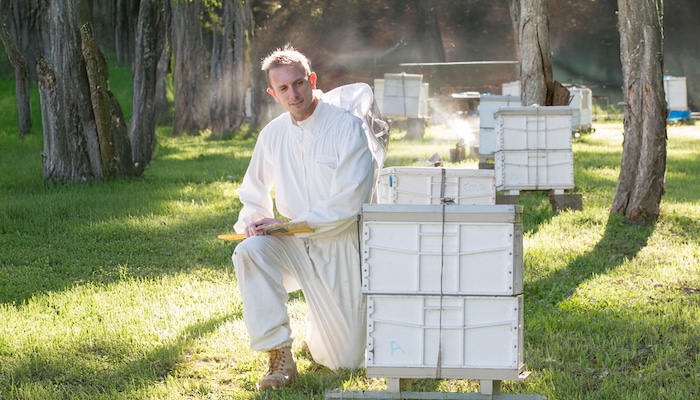- Researchers at Macquarie University found that hibiscus harlequin bugs adapt their colouring depending on the temperature, becoming more orange in hotter climates
- Their striking colouring was thought to have developed to ward off predators, but the study reveals the climate also plays a significant role
- As spring approaches, the orange and iridescent blue bugs are a common sight in gardens in eastern and northern Australia
As temperatures in Australia and around the world increase, for hibiscus harlequin bugs, the future is orange.
Many insects, such as hibiscus harlequin bugs, Tectocoris diophthalmus, also known as ‘stinkbugs’, have evolved bright colours to ward off predators.
It would be expected that all insects of the same species would have the same colours to deter their predators, yet there is often a large variation in colouring within a species.
A new study from Macquarie University tested whether environmental conditions could be behind the dramatic variation in hibiscus harlequin bugs’ colours from pure orange to patterned with iridescent blue.
The researchers compared bugs from Sydney, Brisbane and Darwin and found that bugs were less iridescent and more orange when they came from areas with higher temperatures and more rainfall. However, when the bugs were kept in cold or warm temperatures, they tended to adapt their colouring to look more like the bugs native to that climate.
“Warning colours are often thought to be mainly driven by evolutionary responses to predation,” says lead author Dr Scott Fabricant.
“However, our study shows that the environment where an individual lives can also change their colour, which means predators in different areas must learn and respond to the differing appearance of the bugs.”
The level of colour adaptation varied between populations, as co-author Dr Emily Burdfield-Steel explains: “Interestingly, bugs from up around Darwin tend to be more orange even when raised at the same temperatures as those from Sydney, while the temperate-climate bugs took on the orange hue more readily when kept in warmer temperatures.
“Our research reveals that there are a number of factors influencing the variation in colours, and it’s not as simple as avoiding predators.”
Fabricant SA, Burdfield-Steel ER, Umbers K, Lowe EC, Herberstein ME. Warning signal plasticity in hibiscus harlequin bugs. Evolutionary Ecology. July 2018. https://doi.org/10.1007/s10682-018-9946-3



